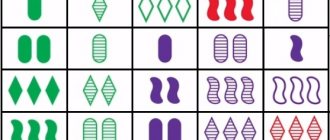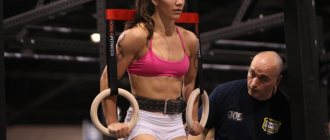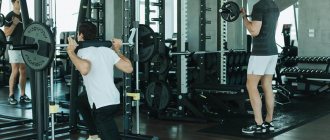Author: Timko Ilya - the ruler of the entire site and fitness trainer | more details >> Rod. 1984 Trained since 1999 Trained since 2007. Author and creator of the site tvoytrener.com. CCM in powerlifting. Champion of Russia and South Russia according to AWPC. Champion of the Krasnodar region according to IPF. 1st category in weightlifting. 2-time winner of the Krasnodar Territory championship in t/a. Author of more than 700 articles on fitness and amateur athletics. Author and co-author of 5 books.
Place in the author rating:
out of competition
(become an author)
Date:
2014-09-18
Views:
18,716
Rating:
5.0
| All articles by the author >> | Medals articles >> |
Articles are loading...
Dropsets are one of the techniques in bodybuilding that is quite widely used to achieve muscle failure. From English “drop” is translated as “drop”. In general, the name speaks for itself. So:
A drop set is an approach during which the weight of the weight decreases.
That is, at the moment the approach is completed, the discs are thrown off the bar (if the weight is on the bar). Hence the name drop set.
For example, you perform biceps curls with a 40 kg barbell for 10 repetitions. After the tenth repetition, you are no longer able to continue the approach. Then the assistants immediately drop 5 kg each and there are already 30 kg on the barbell. And you can do another 4 – 6 repetitions. Then they lose another 5 kg. And you do another 5–8 repetitions with an empty bar. And all this happens without interruption within one approach. I think the point is clear.
In general, drop sets are better and more correct to do with assistants. This will allow you to perform the approach without interruption. But if there are no assistants, then you can do it yourself. However, in this case, you will have to interrupt the approach to throw off the discs yourself. And if this exercise is a squat with a barbell or a bench press, then doing it yourself is very inconvenient.
I think you already understand what drop sets are. Let's now find out why they are needed.
What are drop sets
Everyone is familiar with the standard training method, when the athlete does a certain number of repetitions, gradually increases the weight of the apparatus and rests between each approach. This method of performing exercises loses effectiveness over time as a result of muscle adaptation to the same type of load. To “shock” the muscles and give an impetus to growth, drop series are used.
The technique involves performing each set in an exercise until muscle failure occurs. There is no recovery pause between approaches, and the weight of the projectile is gradually reduced (by 20–25%). As a result, an unusual load is created for the muscles, and muscle fibers that were not previously involved in the exercise are activated.
The definition may seem confusing and complex. To improve understanding, here's an example of a classic drop set.
Let’s take the “bench press” exercise. Let's say you do a bench press with 80 kg for 12 reps, and then you experience failure. At this moment, place the barbell on the supports, but do not remove your hands. Have partners quickly lose 10 kg on each side. After this, do a set to failure with a 60 kg barbell. The main thing is that the pause between sets is minimal.
What is a drop set in bodybuilding?
Drop sets are a training method in which you perform a set of any exercise to failure, then reduce the weight on the apparatus and perform more repetitions. According to Arnold's Encyclopedia of Modern Bodybuilding, the method was originally discovered in 1947 by Henry Atkinson, editor of Body Culture magazine. Atkins called this training a “multi-weight system.” Many years have passed, and this mass-gaining technique has gone by many names: crushing, triple drops, drop sets, weight drops, strip sets, and the weight drop method.
The significance of the technique
Drop sets in bodybuilding are used to increase muscle volume. The effectiveness of this training scheme for muscle growth is due to the following beneficial properties:
- Multiple microdamages of muscle fibers as a result of exposure to stress loads.
- Increased blood flow, facilitating the rapid flow of nutrients into the fibers.
- A powerful pumping effect (“pumping”) that helps to qualitatively improve muscle relief.
- Stimulation of the production of anabolic hormones as a result of prolonged forceful impact on the muscles.
Drop sets in strength training help overcome the “failure point” - the state in which an athlete cannot perform another full repetition. As a result, ligaments and tendons are strengthened and the neuromuscular connection is improved. All together this makes the bodybuilder stronger and more resilient.
What are drop sets and who invented them?
Drop sets in bodybuilding are a special technique that involves performing a set to the last strength, after which the working weight is reduced and work continues.
This unusual, but very popular technique was first used by Henry Atkinson. Back in 1947, he worked as an editor at the publication Body Culture. For seventy years, the drop set program was called strip sets or decreasing sets, although the essence did not change. We will look further into which muscles are best to perform them on and what recommendations should be followed.
Varieties
We offer working types of drop series:
- Strip sets . The technique is similar to drop sets and is designed for muscle growth. Strip sets are exercises performed for 3-4 approaches until failure occurs in each. The weight reduction step is 15–25%. There are no pauses. Equipment used: barbells, dumbbells, kettlebells, block exercise machines. Example: bent-over dumbbell rows – 4 sets (18 kg, 15 kg, 12 kg, 9 kg).
- Tight drop sets . The execution scheme involves a smaller weight reduction step in the approaches - 5–15%. This allows you to increase the intensity of training, but at the same time increases the risk of overtraining. Tight drop series are usually used to work small muscle groups. Example: EZ-bar biceps curl - 4 sets (20 kg, 18 kg, 16 kg, 14 kg).
- Large drop series . The technique is based on an increased step of reducing weight loads - 30-40%. Large drop sets are used in strength training for mass. The advantage is that it works large muscle groups, the disadvantage is that it puts stress on the heart. Most often, this technique is used in basic elements. Example: barbell squats - 3 sets (100 kg, 70 kg, 40 kg).
- Method 6–20 or 50% drop series . The scheme involves performing only two repetitions, the difference in weight between which is 50%. The method combines a low-repetition strength approach with a high-repetition pumping set. As a result, the muscles receive a “shocking” load, which helps them grow. Example of a 50% drop series: T-bar row - 6 reps (60 kg) + 20 reps (30 kg).
- Power drop sets . The technique is based on working with heavy weights for a given small number of repetitions. The weight load reduction step does not exceed 10–15%. The method is intended to develop the athlete's strength abilities. The downside is the heavy load on the heart. Example: deadlift - 4 sets of 6 reps each (100 kg, 90 kg, 80 kg, 70 kg).
- Drop series with changing the position of the legs or grip . Used to work large muscle groups. The step in reducing weight loads is small - 10–15%. The method allows you to change the load on the muscles by applying different force vectors. Example: row of the bar towards you on the lower block while sitting - 3 approaches (wide straight grip - 35 kg, narrow reverse - 31 kg, parallel narrow - 26 kg).
- Triple and quarter drop sets . An expanded version of the classic drop series. The triple involves three approaches to failure with a decrease in weight by 25% for sets 2 and 3, the quarter involves the same thing, but for 4 sets. Used to increase muscle mass by creating a “shocking” load. Example of a triple drop series: overhead pull-down - 3 sets (45 kg, 34 kg, 25 kg).
- Progressive drop set . Combines several types and is suitable only for professionals. Let's explain using the bench press as an example. We do a warm-up approach. Then we select such a weight that failure occurs at the 12th repetition and do the classic drop series. We rest for 2–3 minutes. We set the “failure” weight for 8 reps and do a triple drop set. Rest again for 2-3 minutes. We set the “failure” weight for 6 repetitions and do a quarter drop series.
- Reverse drop set . It does not involve losing weight, but increasing it with each approach. The technique is designed to work out small muscle groups that respond poorly to loads. Example: calf raises in a calf machine - 1 set (20 repetitions), 2 approach (increase the weight of the apparatus and do 12 repetitions), 3 approach (increase the weight again and do 8 repetitions).
- Drop superset . The most powerful training option that literally “explodes” muscles. For example, let's take two exercises for antagonist muscles: dumbbell curls and French presses. We do 12 curls and 12 presses at once. We rest for 10 seconds, reduce the weight by 20% in both exercises and again do 12 repetitions. We perform 4 such super series with reduced weight loads.
What is a drop set in training?
None other than Arnold Schwarzenegger was a lover of drop sets. Let's say thank you to him for popularizing this method, because even today you can observe athletes lifting the biceps apparatus with “dropping the weight” (as Arnold liked to say). However, a regular drop set is only a small part of what such a technique can look like. We managed to collect a dozen creative methods for performing drop sets, which will be discussed below.
Drop sets with a barbell (strip sets)
This method was Arnold's favorite way to train biceps, but it can be applied to almost any exercise we use with a barbell. All you need to do is put small weights on the bar and gradually remove them from each side as you reach muscle failure.
For example, loading a barbell with 4 weights of 5 kg on each side, we get a total weight of 60 kg. Start working with this weight, gradually removing one disk (5 kg) from each side (reducing by 15%). Once you reach 50 kg after the first failure, do 8 more repetitions, then again remove one plate on each side and work with a 40 kg barbell until exhaustion.
Drop sets on a block trainer
Removing the weights from the bar is quite a tedious task, and it can take the necessary seconds (if you work without the help of a partner). It is much easier to perform drop sets on a block trainer. It is enough just to move the pin from the block with the load and stick it a little higher. For example, in a leg machine you can change the weight while sitting still, thereby making the workout more intense.
Drop sets with dumbbells
Working with dumbbells in drop sets (e.g. curls, dumbbell swings, overhead presses) is a very effective approach. For example, you can start dumbbell lateral raises with 18 kg, perform 8 repetitions, put them on a rack and take 15 kg dumbbells. Next, use 10 kg dumbbells and work with this weight to failure. It is enough to try this method once while training your shoulders or biceps to feel how these muscle groups can actually “puff up”.
Dense drop sets (removing light weights)
This method involves decreasing small weights between repetitions. This training regimen is more intense and can in some cases lead to overtraining. Weight reduction per drop set is approximately 15%. In other words, by loading the barbell with 100 kg on the bench press, we first drop the weight to 85 kg, then to 70 kg.
Dense drop sets – weight reduction from 5 to 20%. This technique is used most often to work small muscle groups in isolation exercises. For example, when doing biceps curls, you can start with 20 kg, reducing the weight by 5% and reach 10 kg.
Large drop sets
This involves dropping heavy weights between reps. It is easier to work within this method than with a dense drop set, and you can do more repetitions. Large drop sets put a lot of stress on the heart, and for this reason they are usually used for large muscle groups - squats, bent-over rows, leg presses. For example, you can start doing a drop set on your legs - squats with a 150 kg barbell, gradually dropping 20 kg (30%) from each side of the bar. Then another minus 20 kg (40%). You won't believe it, but this will be the heaviest 110 kg of your life!
50% drop set (“in half” or method 6-20)
The method is similar to large drop sets, but allows you to do reps in two opposite rep ranges, which will attack the muscle cells to their fullest extent. This type of muscle training produces an amazing pump!
After warming up thoroughly, start working with a weight that you can do for 6 repetitions without cheating. After this, without being distracted by rest, reduce the weight on the apparatus by half and do 20 repetitions. For example, you are doing dumbbell rows. If your maximum for 6 repetitions is 50 kg, then, having finished doing them with this weight, immediately take up 25 kg and perform 20 repetitions. You're unlikely to be able to immediately catch your breath after such a drop set, but you will immediately experience incomparable sensations in the latissimus muscles!
Strength drop sets (minimum number of repetitions)
This method was preferred by Larry Scott, the first winner of the Mr. Olympia title. Larry used this technique to gain impressive volume in his shoulders and arms, which was beyond his genetics. He believed that low reps (6 total) with heavy weights were the best way to simultaneously develop mass and strength.
You can do a shoulder drop set in this style, and it will help you increase strength and stimulate muscle fiber growth without much of a pump effect. You need to start with 6 repetitions and gradually reduce the weight on the apparatus by 10-15%. You need to continue working within 6 repetitions even with light weights.
Ascending (6-12-20) and Descending (12-8-4-2) drop sets
Increasing drop sets involve lowering the weight enough to allow for more repetitions. For example, when doing triceps extensions in the upper block with a weight of 45 kg, you manage to do 6 repetitions. This means that then you need to reduce the weight to 35 kg and do 10-12 repetitions. Next - 20 kg for 15-20 repetitions until complete failure.
In decreasing drop sets, you need to do a dense drop set, in which with each series of weight reduction there is a decrease in the number of repetitions. For example, when doing a bench press of 100 kg for 12 repetitions, you need to reduce the weight (5-10%) and do 6-8 repetitions. Then the weight is also reduced and 4-6 repetitions are done. Finally, we finish with a weight that we can do 2 final power reps to failure.
Drop sets with changes in position or grip
This method is one of my favorites because it allows you to work out the muscles completely. For example, in a leg press machine you can train the medial, lateral and adductor muscles at once, or the gluteal and hamstring muscles - all depending on the position of the legs on the platform.
For training, take 25 kg discs (girls can take half the weight). Do 6 to 12 repetitions with your feet shoulder-width apart on the platform. Remove one plate from each side of the bar and perform 6-12 reps with your feet on the top of the platform. Next, remove one more disc from the bar and do the same number of repetitions with your feet placed at the bottom of the platform close to each other. Finish the drop set with the same number of reps by doing one more plate at a time with your feet wide apart on the platform at a 45-degree angle. We drop the weight three times, apply 4 leg positions, and the result is a great leg workout.
Drop sets without rest
This is a very complex training method, and many athletes, consciously or not, avoid it. In such drop sets, there is no rest when changing the weight of the weight. To do one such drop set, naturally, you will need the help of one or two partners. If you try to do the leg press yourself using this approach, you will have to spend time getting up, removing the plates, and continuing the exercise. During this time, lactic acid in the muscles will have time to dissipate, and energy reserves will be actively restored.
If you have two partners, then you can sit quietly in the machine and perform the exercise, squeezing weights that will simultaneously decrease on both sides. The difference between a drop set without pauses and those that use 10-second rests is colossal. This method can be called one of the most difficult to perform, but such a drop set for weight loss is best suited.
Drop sets with rest-pause
This is the exact opposite method to the previous one. When changing the weight, there is a rest of 5,10 or 15 seconds, during which the body has the opportunity to recover a little and continue working with larger weights. The benefit from this is twofold: along with an increase in strength potential, muscle fibers are easily injured, which is also good for gaining weight.
Drop sets-supersets
If drop sets are considered the best high-intensity training in bodybuilding, then who comes in second place? Probably these are supersets. Then what compares to the synthesis of these two most powerful methods - the drop superset?
The essence of the technique is as follows: Select two exercises for a superset. If we are training our shoulders, then we can choose raises with dumbbells to the sides and a dumbbell press in front of us - this will be a superset in which muscle failure will not be achieved. Start doing the first exercise for 8-12 repetitions, for example, with 15 kg dumbbells. After this, proceed to bench press with 30 kg dumbbells with a minimum rest of 8-12 repetitions. Next, for fly-ups, take 10 kg dumbbells, and after that, for the next bench press, take 25 kg dumbbells. And finally, the final approach with 7 kg dumbbells for flyes and after that immediately bench press with 20 kg dumbbells. And this is ONE drop superset. Be careful with this technique, because the method is really super intense.
The difference between drop sets and negative reps
Drop series and negative repetitions are techniques that have a common purpose - “shocking” muscle fibers, but different methods of execution.
Drop sets are based on positive loads. That is, a force effect on the muscles is created when lifting the projectile (positive phase of the exercise). The result is the appearance of micro-tears in the fibers and the production of anabolic hormones. This contributes to a gradual increase in muscle mass, as well as the development of the athlete’s strength abilities.
Negative reps involve lowering the weight in a controlled manner. That is, first you load the projectile as much as possible, then, with the help of a partner, lift it to the highest point of the amplitude, and then very slowly lower it to the starting position.
The essence of the technique: intense stretching of the muscles while slowly lowering the projectile creates an extremely unusual load for them. Because of this, muscle fibers receive multiple microtraumas. In addition, the production of growth hormones increases. As a result, the muscles receive a powerful impulse to increase.
Both techniques place stress on the muscles. But do not forget that joints, ligaments, tendons, the heart, and the nervous system receive excess stress. Using drop series or negative reps too often can lead to overtraining. The latter threatens to stop progress, reduce strength indicators, deteriorate mood, disappearance of motivation for training, and general lethargy of the body.
The recommended frequency of using drop series and negative repetitions is once every 2–3 weeks.
On the back
Which muscles are best for drop sets? You can use any groups, including large back muscles. For example, a bent-over row of a lower block or a barbell is considered a good exercise. You can work with an assistant or independently.
Set the working weight for 12 technical reps. Do them and reduce the load by 20 percent, and then work to failure and reduce the weight again, and again to failure. It's simple but effective.
You can also do drop sets in bodybuilding on the shoulders, triceps, calf muscles and even the abs. There are many variations of writing training programs with triple drop sets, and we advise you to definitely try at least one of the options, including Andrey Skoromny’s program.
Rules for performing drop sets
Performing intense strength sets without pauses can cause injury. To prevent this, follow the recommendations:
- Prepare weights in advance so you don’t have to run around the gym looking for the necessary weights. Haste in working with iron often leads to projectiles falling out of your hands.
- Take breaks. Even if you are an experienced trained athlete, the first time you use drop series, add 10-15 second breaks between approaches.
- Select the correct weight of the projectile. The load on the first set of a drop set should be such that you experience muscle failure by the twelfth rep.
- Use the help of your partners. It is more convenient to perform the same bench press when colleagues drop weight between sets. This minimizes pauses and reduces the risk of injury.
- Do not use the drop set technique more than once every 2 weeks. Regular use of this exercise regimen can lead to the development of overtraining.
- Be sure to warm up before each session. Drop series are a power type of load, so unprepared, unheated muscles are easy to injure.
- Do not use more than 2 drop series per muscle group. Excessive overstrain of muscle fibers can cause the opposite effect - they will begin to break down.
- Do not use drop sets if you are a beginner athlete. Such techniques are contraindicated for beginners, as they create a large load on the heart and central nervous system.
Recommendations for performing a drop set
1. Perform drop sets if the muscles have had a good rest. The main goal is to shock the muscles from an unusual load, reaching the peak of contraction and muscle failure, and tired muscles are not able to give stress to the body, the result is not a shock, but a slight surprise











